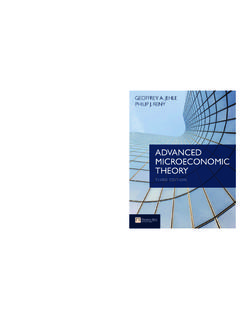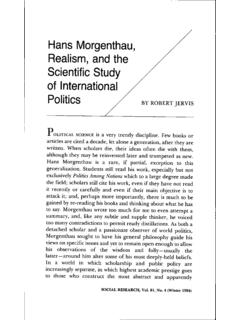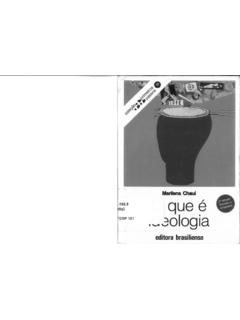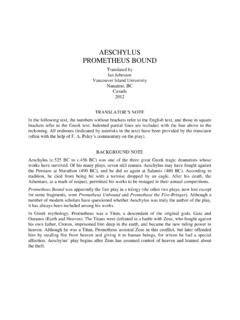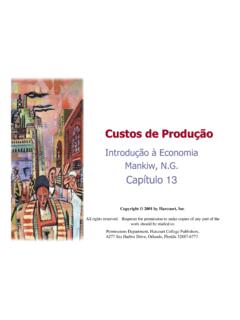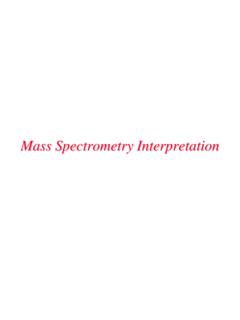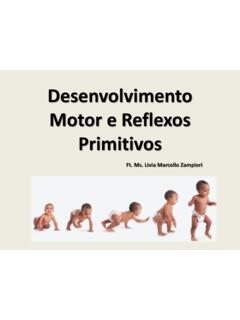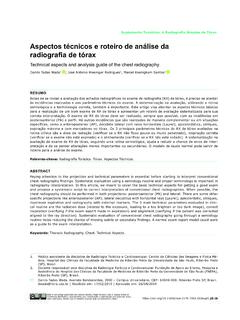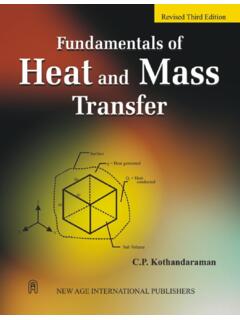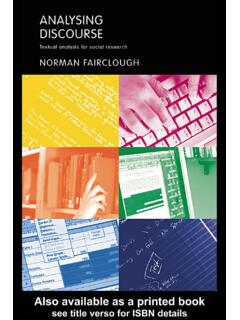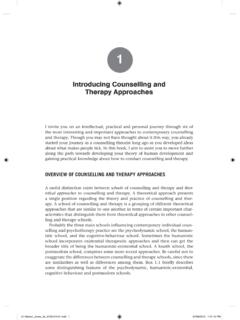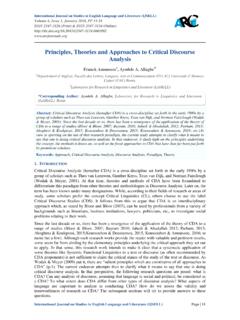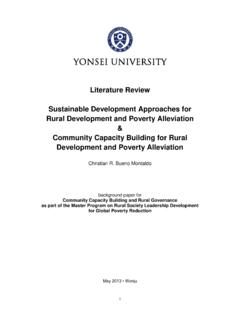Transcription of APPROACHES & METHODS IN LANGUAGE TEACHING: …
1 Metodologia e Ensino de Ingl s I. APPROACHES & METHODS IN LANGUAGE . TEACHING: PREPARING THE TERRAIN. Profa. Dra. Ana Paula Duboc Do you know what concept maps are? Warm-up 1: concept map LANGUAGE The tree metaphor (Monte M r,2009). CLASSROOM TECHNIQUES. TEACHING METHODS . Where do I. CONCEPTS: stand here? LANGUAGE , KNOWLEDGE, PEDAGOGY. Study Reference: The nature of APPROACHES and METHODS in LANGUAGE teaching. In: Richards, J. ;. Rodgers, T. APPROACHES and METHODS in LANGUAGE teaching. Cambridge: CUP, 1999. Fifteenth printing [Original 1986]. Anthony's terminology The arrangement is hierarchical.
2 The organizational key is that techniques carry out a method which is consistent with an approach .. An approach is a set of correlative assumptions dealing with the nature of LANGUAGE teaching and learning. An approach is axiomatic. 1t describes the nature of the subject matter to be taught.. Method is an overall plan for the orderly presentation of LANGUAGE material, no part of which contradicts, and all of which is based upon, the selected approach. An approach is axiomatic, a method is procedural. Within one approach, there can be many METHODS .. A technique is implementational - that which actually takes place in a classroom.
3 It is a particular trick, strategem, or contrivance used to accomplish an immediate objective. Techniques must be consistent with a method, and therefore in harmony with an approach as well. (Anthony 1963, p. 63-7 apud Richards and Rodgers, 1999, p. 15) . Richard and Rodgers's terminology We see approach and method treated at the level of design, that level in which objectives, syllabus, and content are determined, and in which the roles of teachers, learners, and instructional materials are specified. The implementation phase (the level of technique in Anthony's model) we refer to by the slightly more comprehensive term procedure.
4 Thus, a method is theoretically related to an approach, is organizationally determined by a design, and is practically realized in procedure. (ibid, p. 16). Richard and Rodgers's terminology The first level, approach, defines those assumptions, beliefs, and theories about the nature of LANGUAGE and the nature of LANGUAGE learning which operate as axiomatic constructs or reference points and provide a theoretical foundation for what LANGUAGE teachers ultimately do with learners in classrooms. The second level in the system, design, specifies the relationship of theories of LANGUAGE and learning to both the form and function of instructional materials and activities in instructional settings.
5 The third level, procedure, comprises the classroom techniques and practices which are consequences of particular APPROACHES and designs . (Richards & Rodgers, 1986, p. 154 apud Kumaravadivelu, 2006, p. 86). METHOD = an umbrella term referring to a broader relationship between theory and practice In: Brown (2000). Task 1. In Richards and Rodgers's framework, the design part comprises the following aspects: The objectives of a certain method The LANGUAGE content selected and organized (the syllabus). The types of activities used The role of the teacher The role of students The role of instructional materials (coursebooks and the like).
6 By making use of your personal, academic, and professional knowledge, brainstorm ideas/provide examples for each of the aspects listed above. Examples: how many objectives can come up with when it comes to the teaching/learning English? How many classroom activities can you think of? How might teachers behave/teach/act? How about the students? Rodgers (2001). Task 2. 1. Identify the theories of LANGUAGE presented in the text. How do they connect to your previous background knowledge (mainly academic ones)? 2. Identify the theories of learning presentend in the text.
7 How do they connect to your previous background knowledge (mainly, academic ones)? meaning making #1. History of LANGUAGE teaching: introduction Antes da Renascen a: predom nio da l ngua falada; ensino natural Da Renascen a Revolu o Industrial: aumento do prest gio do latim e do grego; desenvolvimento de idiomas vern culos; fasc nio com a era cl ssica e a necessidade de sistematiza o do ensino das l nguas cl ssicas; surgimento do m todo tradicional (Grammar-Translation Method): Objetivo: ler textos can nicos Conte do: gram tica e vocabul rio Atividades: memoriza o, repeti o e tradu o ( em vez de uma t cnica de ensino nascia uma liturgia , Chagas, 1979, p.)
8 26). Papel do professor: detentor e transmissor de conhecimento Papel do aluno: reprodutor do conhecimento (aluno-balde, cf. Machado). Papel do LD: essencial, nica fonte de saber Grammar Translation Method Brown (1997); Richards & Rodgers (2000). dominated Europe from 1840s to 1940s previously referred as Classical Method a method without a LANGUAGE and learning theory . major focus on Reading and Writing little or no attention to Listening and Speaking vocabulary selection endless lists of words and unusual grammar rules to be memorized emphasis on Accuracy deductive learning: first the LANGUAGE is presented, then it is practiced.
9 When was this book first published? 1894. What is its underlying theory of LANGUAGE ? Theory of learning? Attention to the teaching of moral principles and universalizing treatment of the subject Phonological content: structure-based First half of the XX century: vocabulary lists; translation; verb conjugation; biased and prejudiced ideas imbued in sentences such as That negress has very good teeth and A European is generally more civilized than an African to be translated to Portuguese (Paiva, 2009) A gram tica da l ngua ingl sa, First edition 1880 (34th edition, 1940).
10 Transition Period mid / late 19th century: linguists raised new ways of teaching for new social demands related to increasing opportunities for communication among Europeans. emphasis on oral proficiency became essential! At the very beginning, there was a boom of conversation or phrase books for private study. Later, the courses started to take into account other aspects of the LANGUAGE learning process. Marcel (1793 1896): on the importance of meaning in learning;. Prendergast (1806 1886): on the importance of considering context and different discursive situations Gouin (1831- 1896): a LANGUAGE is associated to movements or actions in a contextualized way (which would then lead to a more recent method called TPR) and others.
